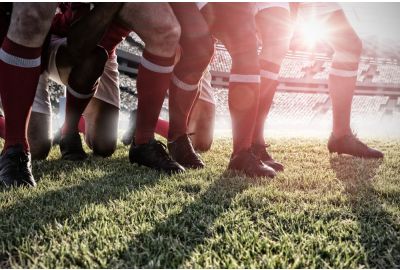If you're a regular rugby viewer, you'll probably have noticed that modern rugby jerseys have a little rectangular lump on the back, located somewhere between the shoulder blades. If you've ever wondered what this is, then the retro rugby shirt experts at TOFFS are here to explain it all!
Anyone with a passing familiarity with sports science knows that kit designs are evolving all the time to unlock new advantages and marginal gains for the athletes out on the field. However, that little bump you'll see on contemporary rugby shirts is more than just a design element - in fact, it houses a small GPS tracker that provides players and coaches alike with significant amounts of data, which plays a key role in shaping fitness regimes and sporting tactics.
Read on to learn more about the rise of this technology in recent years, and the game-changing benefits it's helping to unlock for today's elite athletes.
The rise of the GPS tracker
Whether it's rugby league or rugby union, there's no denying that the sport has come a long way from its roots, and technology has played a pivotal role in shaping the modern game. It's always been a physical contest, but in the 21st century, our understanding of sports science is so high that every move counts, and peak performance is needed from every player in every game to reach the top level.
It's against this backdrop that the GPS tracking device has become popularised as an essential piece of kit for forward-thinking teams. This has been a relatively recent development in rugby, but since the 2010s, the sport took inspiration from Australian rules football and American football - where these trackers have been commonplace for a lot longer - and introduced them as a standard component of the matchday gear that players wear.
To simply call them a "GPS tracker" is actually something of a misnomer - in reality, these little gizmos offer a highly sophisticated biometric tracking system, giving the physios and head coach access to a massive range of data and variables that reveal key insights into how the player is performing out on the field.
Because the advantages offered by these devices are so significant, they've become ubiquitous, to the point that modern kit manufacturers will usually include a purpose-designed pocket at the top of the back, into which the device can be inserted. Alternatively, you might also sometimes see rugby players wearing a chest harness that looks similar to a sports bra, which can also be used to hold the GPS tracking device and collect other biometric data.
What are coaches and players learning from the GPS tracker data?
It's no exaggeration to say that these GPS trackers have revolutionised the way coaches and players approach rugby. These devices offer a wealth of valuable information, allowing for data-driven decisions and enhanced performance on the field. Here's a closer look at what coaches and players are learning from GPS tracker data:
- Detailed performance metrics: GPS trackers provide exhaustive data on various aspects of a player's performance. Coaches can access information on a player's movements, how much ground a player covers during a game, their average speed, and even the force generated by tackles. This data enables coaches to gain insights into how long-term performance trends, and tailor their tactics and practice sessions accordingly.
- Real-time data analysis: one of the most valuable aspects of having players wear these trackers is that they provide all this information in real-time, allowing coaches and medical staff to access the information live on their mobile phones or tablets. This accessibility allows them to closely monitor performance as play unfolds during a game, providing a wealth of information to help coaches make informed decisions about player substitutions and tactical adjustments.
- Injury prevention: GPS data is not limited to improving sporting performance; it plays a crucial role in injury prevention. By tracking sudden changes in a player's different speeds or movement patterns, coaches and medical staff can identify potential issues before they escalate into injuries; they can also review the data to judge the force caused by a tackle when reviewing potential head injuries. This proactive approach ensures that players receive timely attention, and reduces the risk of long-term health issues.
- Heart rate tracking: in addition to GPS trackers, rugby players will often wear a heart rate monitor, securely strapped around the chest to provide continuous data on the player's heart rate throughout the game. Heart rate data is an integral part of the performance equation, allowing coaches to gauge a player's fatigue levels, distance covered and overall fitness in real time. Sudden spikes in heart rate can indicate stress or exhaustion, and this information can be used to guide tactical and medical decisions. In this way, the heart monitor enhances player safety and optimises their performance at the same time.
GPS tracker data has become an indispensable tool in modern rugby. Coaches and players alike benefit from the real-time insights these devices provide, and their widespread adoption is a real testament to how new technology continues to shape and advance the world of sports. It's why you'll see so many other sports - from football to athletics - also embracing this technology in recent years, and shows just how much thought goes into providing fans with the best possible sporting spectacle.
So next time you watch a rugby match and see players wearing those trackers on the back of their shirts, you can marvel at how far this historic sport has evolved!
Of course, here at TOFFS, we're all about celebrating the past as much as the future, so if you're nostalgic for a simpler time, then take a look at our complete range of retro rugby kits!











